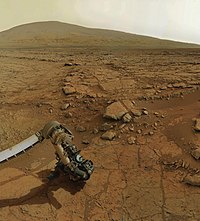
Photo from wikipedia
Jezero Crater on Mars is a paleolacustrine environment where Mg-carbonates may host evidence of ancient life. To elucidate the environmental and mineralogical controls on biosignature preservation, we examined samples from… Click to show full abstract
Jezero Crater on Mars is a paleolacustrine environment where Mg-carbonates may host evidence of ancient life. To elucidate the environmental and mineralogical controls on biosignature preservation, we examined samples from five terrestrial analogs: Lake Salda (Turkey), Lake Alchichica (Mexico), Qinghai-Tibetan Plateau (China), Mg-carbonate playas (British Columbia, Canada), and a mine with fine-grained ultramafic tailings (Yukon, Canada). The mineralogical compositions of the samples varied, yet were often dominated by either aragonite (CaCO3) or hydromagnesite [Mg5(CO3)4(OH)2·4H2O]. Aragonite-rich samples from Alchichica, Mg-carbonate playas, and the ultramafic mine contained an abundance of entombed microbial biomass, including organic structures that resembled cells, whereas hydromagnesite-rich samples were devoid of microfossils. Aragonite often precipitates subaqueously where microbes thrive, thereby increasing the likelihood of biomass entombment, while hydrated Mg-carbonates typically form by evaporation in subaerial settings where biofilms are less prolific. Magnesite (MgCO3), the most stable Mg-carbonate, forms extremely slowly, which may limit the capture of biosignatures. Hydrated Mg-carbonates are prone to transformation via coupled dissolution-precipitation reactions that may expose biosignatures to degradation. Although less abundant, aragonite is commonly found in Mg-carbonate environments and is a better medium for biosignature preservation due to its fast precipitation rates and relative stability, as well as its tendency to form subaqueously and lithify. Consequently, we propose that aragonite be considered a valuable exploration target on Mars.
Journal Title: Astrobiology
Year Published: 2023
Link to full text (if available)
Share on Social Media: Sign Up to like & get
recommendations!